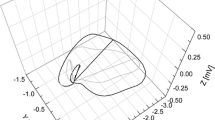Summary
In order to confirm or refute the previously held view that electrocardiographic (ECG) abnormalities are frequent in diabetic ketoacidosis, we have undertaken continuous ECG monitoring for 24 h, with subsequent computer analysis, in 14 diabetic patients admitted with severe ketoacidosis. There was a steady fall in heart rate during the 24-h except in 3 severely dehydrated patients. Depression of the ST-segment was minimal and ST-segment height correlated significantly with heart rate, whereas no consistent relationship was found between T-wave amplitude and either heart rate or plasma potassium. Two patients developed short periods of supraventricular ectopic beats. Although ECG monitoring has been claimed to be a useful aid in the management of diabetic ketoacidosis, this study clearly demonstrates that significant ECG changes are rare and ECG monitoring thereafter adds little to careful clinical observation and regular biochemical assessment.
Similar content being viewed by others
References
Alberti K. G. M. M.: Management of ketoacidosis — In:Ledingham J. G. G. (Ed.): Tenth symposium on advanced medicine. Pitman, London, 1974; p. 68.
Barker P. S., Shrader E. L., Ronzoni E.: The effect of alkalosis and of acidosis upon the human electrocardiogram — Amer. Heart J.17, 169, 1939.
Beigelman P. M., Warner N. E.: Thirty-two fatal cases of diabetic ketoacidosis, including a case of mucormycosis — Diabetes22, 847, 1973.
Bellet S., Dyer W. W.: The electrocardiogram during and after emergence from diabetic coma — Amer. Heart J.13, 72, 1937.
Campbell I. W., Munro J. F., Maccuish A. C., Duncan L. J. P.: Infection and severe metabolic decompensation — Practitioner213, 813, 1974.
Clarke B. F., Campbell I. W.: Multiple complications in severe diabetic ketoacidosis. A short review of the literature — Acta diabet. lat.12, 327, 1975.
Duncan L. J. P.: Diabetes mellitus — In:Alstead S., Girdwood R. H. (Eds): Textbook of Medical Treatment. 13th ed. Churchill-Livingstone, Edinburgh-London, 1974; p. 380.
Henderson C. B.: Potassium and the cardiographic changes in diabetic acidosis — Brit. Heart J.15, 87, 1953.
Keller U., Berger W., Ritz R., Truog P.: Course and prognosis of 86 episodes of diabetic coma. A five year experience with a uniform schedule of treatment — Diabetologia11, 93, 1975.
Magida M. G., Roberts K. E.: Electrocardiographic alterations produced by an increase in plasma pH, bicarbonate and sodium as compared with those seen with a decrease of potassium — Circulat. Res.1, 214, 1953.
Martin H. E., Wertman M.: Electrolyte changes and the electrocardiogram in diabetic acidosis — Amer. Heart J.34, 646, 1947.
McAllen P. M.: The electrocardiogram associated with low levels of serum potassium — Brit. Heart J.13, 159, 1951.
Nadler C. S., Bellet S., Lanning M.: Influence of the serum potassium and other electrolytes on the electrocardiogram in diabetic acidosis — Amer. J. Med.5, 838, 1948.
Neilson J. M. M., Davies C. T. M., Kitchin A. H.: Method for recording electrocardiographic wave-form changes continuously — Brit. Heart J.30, 872, 1968.
Soler N. G., Bennett M. A., Fitzgerald M. G., Malins J. M.: Intensive care in the management of diabetic ketoacidosis — Lancet1, 951, 1973.
Soler N. G., Bennett M. A., Fitzgerald M. G., Malins J. M.: Electrocardiogram as a guide to potassium replacement in diabetic ketoacidosis — Diabetes23, 610, 1974.
Smith K. S., Hickling R. A.: Electrocardiographic changes during treatment of severe diabetes — Lancet1, 501, 1932.
Stenzel K. H., Dougherty J. C., Scherr L., Lubash G. D.: Diabetic ketoacidosis. Dissociation of plasma potassium levels and electrocardiographic abnormalities — J. Amer. med. Ass.184, 372, 1964.
Vetter N. J., Julian D. G.: Comparison of arrhythmia computer and conventional monitoring in coronary-care unit — Lancet1, 1151, 1975.
Author information
Authors and Affiliations
Rights and permissions
About this article
Cite this article
Harrower, A.D.B., Murray, A., Campbell, I.W. et al. The value of continuous ECG monitoring during treatment of diabetic ketoacidosis. A computer study. Acta diabet. lat 15, 88–94 (1978). https://doi.org/10.1007/BF02581011
Received:
Issue Date:
DOI: https://doi.org/10.1007/BF02581011




